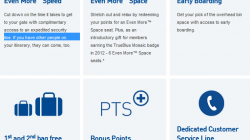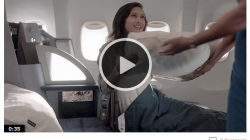The United Airlines’ ‘Sweep,’ developed by Saul Bass in 1974, remains one of the most iconic logos in aviation history.
And just like that, it went from, “It’s Time to Fly,” to “You’re going to need a bigger map.”
The former slogan, first unveiled at Superbowl XXXVIII in February 2004, will forever be remembered as the last of many marketed by United Airlines before it was officially retired in 2011, just after its October 1, 2010 official merger with Continental Airlines, Inc.
Along with it went the tulip logo, animated commercials and cartoon advertisements, the battleship grey (or was it blue and white?) livery, among other things, including the free Starbucks coffee served on board.
It can otherwise be described as practicalities involved in what Business Week magazine describes as, “A Marriage at 30,000 feet.” In an article published earlier this month, BW author Drake Bennett provides a detailed, behind the scenes discovery of the intricate webs involved in an airline integration, such as this particular one with United and Continental, in “Making the World’s Largest Airline Fly.”
Pre-merger announcement, United and Continental, although members of the same airline member alliance, Star Alliance, only competed directly on seven routes throughout their worldwide network. As such, it made sense on paper for the two carriers to combine to broaden their networks and offer their customers more access to a wider reaching away of markets, both business and leisure-oriented, without fear of cannibalizing each other’s existing shares. Continental had a strong presence in New York, Europe, Latin America and Micronesia, but was weak elsewhere. United had a strong US West Coast presence and Transpacific network. Although there were other pieces of the puzzle to consider, the impetus for consolidation as a means of achieving profitability in the US airline industry essentially set the wheels in motion for the UA-CO merger.
The new UNITED will overtake Delta airlines to be the #1 largest carrier in the world, by passengers transported and destinations served.
“If I could personally greet every passenger on this airplane, what I would say to you is, ‘Thanks for flying with us, and I’d tell you we’re going to do our very best to take good care of you.'” – United CEO Jeff Smisek, in the new United in-flight safety video, launched in January 2012.Streamlining end-to-end decisions: not so easy
If the United-Continental merger were to be described as a perfect wedding, well then, in matrimonial terms, its planning and execution process might as well be as challenging as “having the actual ceremony take place 30,000 feet up in the air.”
While seemingly an easy decision to make, choosing between two coffee brand offerings in and of itself presented to be a challenge for the new carrier (which chose to retain the United name, but adopt the Continental logo), representing just one of many endless integration challenges in the merger. Bennett describes how Continental used Fresh Brew, and United used SBUX, yet “with one food-service supply chain, it made no sense to maintain two coffee contracts,” so it had to choose between one.
With enough coffee brewed at 37,000 feet to serve 62 million cups each year, the new carrier could not afford to choose a brand that left bitter tastes on the tongues of its customers. Much like at a wedding ceremony, heaven forbid if the planners serve nasty wine or rotten champagne. Therefore, aside from costs savings, positive feedback from taste tests were given high priority over a period of several months.
Bennett describes the painstaking process involved from there on out. Everything from compiling a panel of “taste testers” across work groups, Head United Chef Gerry McLoughlin, CEO Jeff Smisek, all the way to initial launch date and the barrage of complaints received afterward, can only begin to scratch the surface when exploring the headaches involved in a merger.
“Not life or death”
Of course, the example above, as the article states, involves coffee, aka “not life or death.” But what about the deeper challenges that were critical survival characteristics of this merger? United’s flight operations center was based in Chicago; Continental’s was down in Houston. Same issue with the location of each individual airlines’ headquarters. Combining labor forces is also an exceptionally delicate practice, given the nature of seniority levels, as well as the company culture, unique to each individual carrier. Not everyone is happy to see some of those qualities compromised, if not altogether dissolved and started afresh, when merger activities take place.
Flight Informations systems, by far, represents the largest brain piece of the puzzle, according to the article. In order for two merged airlines to receive a Single Operating Certificate (SOC) by the Federal Aviation Administration, data needs to be fully transitioned and warehoused on a single platform that can successfully withstand exhaustive tests to insure that information is communicated accurately and securely across all users. On the ground, a single snarl at an airport kiosk could strand thousands of passengers, resulting in delays, cancellations, and angry customers. The article also mentions how even more disturbingly, any disruptions resulting in lost data on the flights could really throw off critical information on departure and arrival times, destination or flight location.
Finally, another critical element involves the passenger flight information data, which remains warehoused on two separate databases, although it is expected that this will be in the clear by early March. Theoretically speaking, both airlines still use two separate websites and provide two separate loyalty programs. Still, dry runs have been ongoing to insure that transition will occur with minimal issues next month.
And, with those changes in place, the end-to-end process will become unified.
Starting with reservations. A single team of agents, instead of two, will be answering phone calls on one advertised reservation number, 1-800-UNITED-1.
Continental’s website, www.continental.com, will be re-routed to www.united.com.
Remaining aircraft with the ‘Continental’ title pained on its fuselage, or with the United battleship grey/blue and white tulip liveries, will slowly drop to 0.
Passengers will accrue miles on United’s MileagePlus program, as well as check-in, queue-up, and see the word ‘United’ bearing the name of the airline they are flying at each point of the journey.
And on March 1, United will also launch a new coffee, a Fresh Brew blend called Kova, but that contains a medium roast instead of a light one.
Moving forward
Because of on-going labor negotiations, flight crews will continue to fly separately from both airlines. In addition, the combined carrier will still be streamlining the in-flight product offering on both flights from a hardware aspect. Former Continental planes have DirectTV installed on many of their domestic mainline aircraft, and all existing United aircraft have EconomyPlus premium seating, which will be applied fleet wide over the years.
But it will stilll cary the name United, and United will always be part of its DNA.
United Airlines ‘Sea Orchestra,’ a 2008 commercial advertising its new International First and Business Class on transoceanic flights. “Crossing the Ocean will never be the same.”
References and recognitions:
Business Week, ‘Making the World’s Largest Airline Fly.’
Houston Chronicle, ‘Passengers will fly United after merger next month.’
Special thanks to my sister, Anneka and her friend, Katie, for contributing to this blog post.




